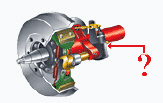True/False
Indicate whether the
statement is true or false.
|
|
|
1.
|
All vehicles with air brakes must have a low air pressure warning signal.
|
|
|
2.
|
When driving, spring brakes are normally held back by the pressure of the
spring.
|
|
|
3.
|
Front wheel braking is good under all weather conditions, so front brake
limiting valves should be left in the “normal” position.
|
|
|
4.
|
Parking (emergency) brakes must be held in position by mechanical pressure, such
as spring pressure.
|
|
|
5.
|
The air compressor governor controls the air pressure applied to the
brakes.
|
|
|
6.
|
When driving a tractor-trailer combination with ABS air brakes, you should brake
normally, regardless of whether you have ABS on the tractor, the trailer or both.
|
|
|
7.
|
If your antilock brake system (ABS) malfunctions and is not working, you have no
brakes.
|
|
|
8.
|
On a long, steep downgrade, use of your air brakes is the primary means of
slowing your vehicle.
|
|
|
9.
|
The service brake system is the brake system that applies and releases the
brakes when the driver uses the brake pedal.
|
|
|
10.
|
The item identified in this picture is the slack adjuster: 
|
Multiple Choice
Identify the
choice that best completes the statement or answers the question.
|
|
|
11.
|
What does an alcohol evaporator do?
a. | Reduce alcohol in the air tanks. | b. | Add alcohol to the air
tanks. | c. | Reduce the risk of ice in the air brake system in cold weather. | d. | Eliminate the oil in
the air brake compressor. |
|
|
|
12.
|
The brake pedal applies and releases the __________ brakes.
a. | emergency | b. | service | c. | secondary | d. | test |
|
|
|
13.
|
The brake pedal controls how much __________ is supplied to the
brakes.
a. | oil | b. | air | c. | time | d. | water vapor |
|
|
|
14.
|
Which vehicles with air brakes must have an air tank supply pressure
gauge?
a. | All vehicles over 26,000 pounds. | b. | All vehicles manufactured after
2001. | c. | All vehicles carrying cargo. | d. | All vehicles with air
brakes. |
|
|
|
15.
|
A straight truck air brake system should not leak at a rate of more than _____
psi per minute with the engine off and the brakes released.
|
|
|
16.
|
The air loss rate for a straight truck with the engine off and the brakes
on should not be more than:
a. | 1 psi in 30 seconds. | b. | 1 psi in one minute. | c. | 3 psi in one
minute. | d. | 2 psi in 45 seconds. |
|
|
|
17.
|
When testing your service brakes, you should NOT have which of the
following?
a. | Delayed stopping action. | b. | Any unusual feel. | c. | A pull to one
side. | d. | All of the above. |
|
|
|
18.
|
Your brakes are fading when:
a. | You have to push harder on the brake pedal to control your speed on a downhill
grade. | c. | The brake pedal feels spongy when you apply pressure. | b. | You hear the brake
fade alarm. | d. | Your speed
increases if you release the brake pedal. |
|
|
|
19.
|
If you must make an emergency stop, brake so you:
a. | Lock up all brakes until you stop. | b. | Can steer and keep your vehicle in a straight
line. | c. | Heat the brakes completely. | d. | Use the hand brake
first. |
|
|
|
20.
|
With air brake equipped vehicles, the parking brakes must be used:
a. | Only whenever the vehicle is unattended by the driver. | b. | Whenever the vehicle
is parked (regardless of whether it is attended or not). | c. | Only when on a hill
or incline. | d. | Whenever the vehicle stops at a traffic light. |
|